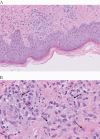Reactivation of Chagas Disease in a Patient With an Autoimmune Rheumatic Disease: Case Report and Review of the Literature
- PMID: 33575423
- PMCID: PMC7863873
- DOI: 10.1093/ofid/ofaa642
Reactivation of Chagas Disease in a Patient With an Autoimmune Rheumatic Disease: Case Report and Review of the Literature
Abstract
Reactivation of Chagas disease has been described in immunosuppressed patients, but there is a paucity of literature describing reactivation in patients on immunosuppressive therapies for the treatment of autoimmune rheumatic diseases. We describe a case of Chagas disease reactivation in a woman taking azathioprine and prednisone for limited cutaneous systemic sclerosis (lcSSc). Reactivation manifested as indurated and erythematous cutaneous nodules. Sequencing of a skin biopsy specimen confirmed the diagnosis of Chagas disease. She was treated with benznidazole with clinical improvement in the cutaneous lesions. However, her clinical course was complicated and included disseminated CMV disease and subsequent septic shock due to bacteremia. Our case and review of the literature highlight that screening for Chagas disease should be strongly considered for patients who will undergo immunosuppression for treatment of autoimmune disease if epidemiologically indicated.
Keywords: Chagas disease; autoimmune rheumatic disease.
© The Author(s) 2021. Published by Oxford University Press on behalf of Infectious Diseases Society of America.
Figures


Similar articles
-
Reactivation of Chagas disease by immunosuppressive therapy in a patient with systemic lupus erythematosus: report of an exceptional case.Am J Dermatopathol. 2012 Aug;34(6):e84-9. doi: 10.1097/DAD.0b013e318257f9e2. Am J Dermatopathol. 2012. PMID: 22814327
-
Reactivation of Chagas' disease: cutaneous manifestations in two immunosuppressed patients.Int J Dermatol. 2012 Jul;51(7):829-34. doi: 10.1111/j.1365-4632.2011.05224.x. Int J Dermatol. 2012. PMID: 22715827
-
Chagas' disease reactivation with skin symptoms in a patient with kidney transplant.Int J Dermatol. 2007 Jun;46(6):607-10. doi: 10.1111/j.1365-4632.2007.03127.x. Int J Dermatol. 2007. PMID: 17550560
-
Hepatitis reactivation in patients with rheumatic diseases after immunosuppressive therapy--a report of long-term follow-up of serial cases and literature review.Clin Rheumatol. 2014 Apr;33(4):577-86. doi: 10.1007/s10067-013-2450-9. Epub 2013 Dec 11. Clin Rheumatol. 2014. PMID: 24343455 Free PMC article. Review.
-
Cytomegalovirus-induced cutaneous ulcer mimicking vasculitis in a patient with systemic lupus erythematous: A case report and review of the literature.Lupus. 2021 Jan;30(1):149-154. doi: 10.1177/0961203320961473. Epub 2020 Oct 5. Lupus. 2021. PMID: 33012246 Review.
Cited by
-
Human Codon Usage: The Genetic Basis of Pathogen Latency.Glob Med Genet. 2021 Sep;8(3):109-115. doi: 10.1055/s-0041-1729753. Epub 2021 Jun 14. Glob Med Genet. 2021. PMID: 34430963 Free PMC article.
-
Trypanosoma cruzi, Chagas disease and cancer: putting together the pieces of a complex puzzle.Front Cell Dev Biol. 2023 Dec 21;11:1260423. doi: 10.3389/fcell.2023.1260423. eCollection 2023. Front Cell Dev Biol. 2023. PMID: 38188016 Free PMC article. Review.
-
Chagas Disease: Comparison of Therapy with Nifurtimox and Benznidazole in Indigenous Communities in Colombia.J Clin Med. 2024 Apr 26;13(9):2565. doi: 10.3390/jcm13092565. J Clin Med. 2024. PMID: 38731093 Free PMC article.
-
Quantitative PCR for parasitemia monitoring and preemptive therapy in patients with Chagas disease and autoimmune rheumatic disorders undergoing biologic treatment: a case series.Rev Soc Bras Med Trop. 2025 Jun 2;58:e008022025. doi: 10.1590/0037-8682-0419-2024. eCollection 2025. Rev Soc Bras Med Trop. 2025. PMID: 40465888 Free PMC article.
-
Trypanosoma cruzi Reactivation After Chimeric Antigen Receptor T-Cell Therapy.Open Forum Infect Dis. 2024 Jan 23;11(1):ofad698. doi: 10.1093/ofid/ofad698. eCollection 2024 Jan. Open Forum Infect Dis. 2024. PMID: 38264096 Free PMC article.
References
-
- Moncada PA, Budvytiene I, Ho DY, et al. Utility of DNA sequencing for direct identification of invasive fungi from fresh and formalin-fixed specimens. Am J Clin Pathol 2013; 140:203–8. - PubMed
-
- Gomez CA, Budvytiene I, Zemek AJ, Banaei N. Performance of targeted fungal sequencing for culture-independent diagnosis of invasive fungal disease. Clin Infect Dis 2017; 65:2035–41. - PubMed
-
- Bern C, Montgomery SP. An estimate of the burden of Chagas disease in the United States. Clin Infect Dis 2009; 49:e52–4. - PubMed
-
- Perez-Molina J, Molina I. Chagas disease. Lancet 2018; 391:82–94. - PubMed
Publication types
LinkOut - more resources
Full Text Sources
Other Literature Sources

